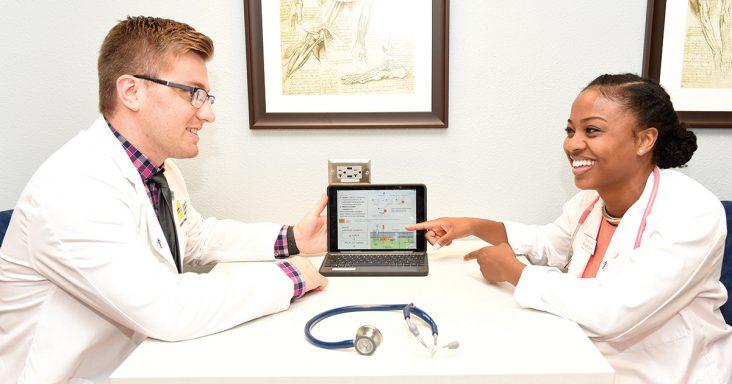NEA DO school hopes doctors will consider rural practices
by March 17, 2019 2:24 pm 906 views

When the efforts began to lure New York Institute of Technology College of Osteopathic Medicine at Arkansas State University (NYITCOM at A-State) to Northeast Arkansas, officials hoped it would help tackle a serious problem in the region. Attracting doctors to rural areas is a real problem, and the first DO school in the state’s history had a goal to develop relationships with rural healthcare providers.
The idea was that DO students would do rotations in these rural areas and it would increase the likelihood that some of these students might practice in these less populated areas, NYIT at ASU Dean Dr. Shane Speights told Talk Business & Politics.
The first third year students in the school’s history have been doing rotations and Speights remains hopeful that some of those students will be practicing medicine in the rural Delta region once they become full-fledged doctors.
“That’s what we are hoping for,” Speights said. “I would say right now is going extremely well. If we can recruit more doctors it could significantly impact the health outcomes in rural parts of the state and region.”
At least one county in every single state has no doctor, according to the Lown Institute. Roughly one in five people in the United States live in rural areas. The patient-to-primary care physician ratio in urban areas is 53.3 doctors for every 100,000 residents, according to the National Rural Healthcare Association. The ratio is 39.8 doctors per 100,000 residents in rural areas.
The problem is deeper than just fewer physicians. Those that live in rural areas of the country make on average $9,242 less than their urban counterparts, NRHA found. This means that residents in rural America are more likely to live at or below the poverty line. About one in four children live poverty. About 14.6% of rural households receive assistance from the Supplemental Nutrition Assistance Program or SNAP, while only 10.9% of urban households receive those benefits, the NRHA reported.
Rural populations tend to be older, have higher usage rates of tobacco products, and have less access to nutritional foods. About half of all vehicle related fatalities occur in rural areas, and there are higher instances of heart disease and diabetes in these places, the NRHA found.
There are a myriad of reasons why physicians tend to want to work in urban places, Speights said. Connectivity is at the top of the list. About 60% of all doctors stay within 100 miles from where they perform their residency, Speights said.
Jonesboro has two residencies and it will increase to four by 2020. St. Bernards will have two and NEA Memorial Baptist Hospital will have two. The school also is involved in creating a rural residency involving Lawrence Memorial Hospital in Walnut Ridge, Five Rivers Medical Center in Pocahontas and other rural hospitals in the region.
The first class from the school is in its first year of rotations. When a student physician is in rotations, he or she is assigned to a practicing doctor and will keep the same schedule as that doctor. That means the student could spend up to 80 hours per week with the doctor, learning first-hand, according to Speights.
The DO school has agreements with healthcare providers statewide and with those in Tennessee, Missouri, and northern Mississippi. Many are in rural clinics and doctors’ offices, meaning students are connecting with those communities and some have even been offered jobs once they complete their residencies, he added.
Some of the students placed in these rural settings pushed back at the beginning of the fall term, but within a week or so nearly all had a change of heart, Speights said.
“It’s very gratifying … we got several emails from students saying, ‘thank you very much,’” he said. “Hopefully this (rural rotations) will serve as a good recruiting tool for our underserved communities.”
Because of the higher rates of poverty, more residents in rural areas don’t have health insurance, which gives the perception that urban doctors make more. Some doctors want to work a set shift, and if you’re the only doctor in town, then you might be on-call much more, Speights said. Other considerations might include spousal wishes, the quality of the local school system, and other factors.
The osteopathic medicine program at ASU was the first of its kind in the state, and when it opened it was only the second medical school in Arkansas. The school has been approved to accept about 115 students per year and will be allowed to carry a maximum of 460 students in total.
A second osteopathic school based in Fort Smith welcomed its first class in the fall of 2017.
The Jonesboro campus is NYIT’s second osteopathic school. The first is based in Old Westbury, N.Y. NYIT and has seven schools and colleges and a student base of about 12,000 from sites around the world. Arkansas classes are held in Wilson Hall on the ASU campus, which underwent a massive renovation before classes began.
The school has a waiting list that is about as long as the students who enroll each year. This school year is coming to an end and the first DO class in Arkansas’ history will be in its final year in 2019-2020. What is Speights looking forward to in the coming school term?
“Graduation. We are really excited to graduate our first class,” he said.
